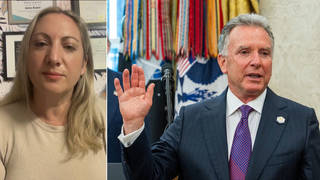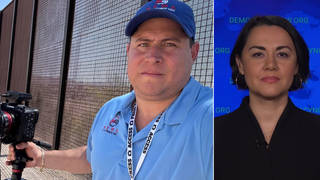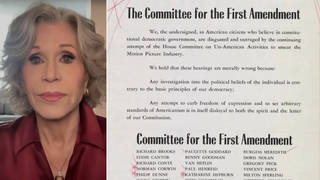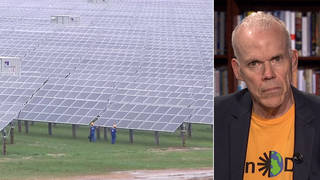
Topics
Guests
- Peter Dykstrapublisher of two environmental news websites, DailyClimate.org, which just published its annual survey, “Climate coverage soared in 2013, spurred by energy, and weather.” Dykstra is also publisher of EnvironmentalHealthNews.org.
A new survey of global climate change coverage in 2013 has found a 30 percent increase in the number of mainstream news articles and editorials on the topic. The website The Daily Climate compiles such stories on a daily basis, and their results showed that for the first time since 2009 there was an increase in global warming reporting. Some 24,000 reports were filed on the topic last year compared to about 18,000 the year before, in 2012. Reuters, the Associated Press and The Guardian each filed more than 1,000 stories. The New York Times was the only major publication to see its climate coverage drop in 2013. Meanwhile, the climate coverage on Fox News continued to feature pundits who argue climate change is a hoax. We’re joined by Peter Dykstra, publisher of The Daily Climate, which just published its annual survey and found that “Climate coverage soared in 2013, spurred by energy, and weather.” Dykstra is a former journalist, spending 17 years at CNN where he covered the environment and weather.
Transcript
AMY GOODMAN: We turn now to a new survey of global climate change coverage in 2013 that found a 30 percent increase in the number of mainstream news articles and editorials on the topic. The website The Daily Climate compiles such stories on a daily basis, and their results showed that for the first time since 2009 there was an increase in global warming reporting. Some 24,000 reports were filed on the topic last year compared to about 18,000 the year before, in 2012. Reuters news agency, the Associated Press and The Guardian each filed more than a thousand stories. The New York Times was the only major publication to see its climate coverage drop in 2013.
Meanwhile, the climate coverage on Fox News continued to feature pundits who argue climate change is a hoax. This is Fox & Friends regular Donald Trump speaking on the show on Monday.
DONALD TRUMP: This whole global warming hoax—you know, one of the great things and—if you notice the way the press—they call them tourists, but all of those people on the ship in Antarctic—Antarctica, that got caught in the ice—you know, the ice is massive there. They started off in an area that didn’t have so much ice, and like within a period of four or five days, they had miles and miles, and they were surrounded by it. Well, they were global warming scientists.
BRIAN KILMEADE: That’s right.
DONALD TRUMP: Now, the media is not saying that. They’re calling them tourists, because it doesn’t play well to say they’re global warming scientists. But they were going there to study global warming. And this winter is brutal. I mean, I’m in New York right now. The airports were closed. Everything is closed. It’s freezing. We haven’t had a winter like this in a long time. And, by the way, forget about New York, everywhere—
BRIAN KILMEADE: Yeah.
DONALD TRUMP: It’s freezing all over the country. You look at places like Texas, they’re setting record lows, and Oklahoma, where they never had problems, they have snow.
ELISABETH HASSELBECK: Sure.
DONALD TRUMP: So, what’s gone on? And it’s not the—the hoax doesn’t bother me, if it didn’t mean anything.
BRIAN KILMEADE: Now, what do you mean, hoax?
DONALD TRUMP: Well, it’s a hoax. I think the scientists are having a lot of fun. It was—I wouldn’t say started, you know, just like Al Gore started the Internet. He’s the one that really is the big proponent. The problem we’re doing is we’re making our manufacturing, our factories and other things—we’re making them non-competitive to other countries. And if you look at what’s going on in China, if you look at what’s going on in India, they’re not spending 10 cents on their factories.
BRIAN KILMEADE: Exactly.
DONALD TRUMP: And then we’re supposed to compete.
BRIAN KILMEADE: Right.
DONALD TRUMP: And you can’t compete when you can’t use fuel.
AMY GOODMAN: That was Fox News regular, real estate magnate Donald Trump, speaking Monday on Fox & Friends.
For more on the media’s coverage of climate change, we’re joined by Peter Dykstra, publisher of DailyClimate.org, which just published its annual survey and found that climate coverage soared in 2013, spurred by energy and weather. He’s joining us via Democracy Now! video stream from Conyers, Georgia, near Atlanta, which, like much of the country, is facing severely cold temperatures right now. Dykstra himself is a former journalist. He spent 17 years at CNN, where he covered the environment and weather, now also the publisher of EnvironmentalHealthNews.org.
Welcome to Democracy Now! So, just what is the weather like where you are right now, Peter?
PETER DYKSTRA: Hi, Amy. It’s an honor to follow Donald Trump. But it’s, I think, about 9 or 10 degrees here, which is not the worst I’ve seen in Georgia in my 20 years here, but [inaudible] cold.
AMY GOODMAN: But it’s cold. So talk about what you found. And maybe you’d like to respond to Donald Trump.
PETER DYKSTRA: If I must. You know, looking at the weather on a specific day or a specific couple of days and making a decree about climate change is nonsense. The only people who believe that are the people who never paid attention or respect to the science in the first place. And the Donald is a poster child for that. I don’t know if I have much more to add about that.
In terms of coverage, though, climate coverage is broadening. It’s not just the science and predictions about what might happen in 20 years, but it’s stuff that’s in our faces and happening right now. It’s all of the alternative energy news, even fracking news, which we’ve seen a huge increase in this year. And climate news is finding its way into other journalism niches—in food stories, when drought causes huge problems with the food supply and for farmers; in security stories, when the polar—the Arctic ice cap melts, and you have countries jostling for position for resources and military position in the Arctic. It’s not just niche journalism anymore, and that’s really where we see this growth.
AMY GOODMAN: And yet, the massive coverage now of weather—everywhere on every network, and so many people are tuning in for it—you rarely see any kind of connection between the meteorologists on television talking about the weather, how cold it is, how you have to bundle up or stay inside, and the issue of climate change.
PETER DYKSTRA: Well, whether it’s a specific cold snap or a specific heat wave, the science tells us that you can’t draw a smoking gun conclusion to what’s happening with long-term climate change. But it is time, with all of the bizarre weather we’ve seen around the world, including now, including the cold weather, including the tragic storm in the Philippines, the record heat in Australia, it’s time to start making connections. And TV, in its failure to cover this, is not just a special case. I think they’re a bit more toward a basket case now. There just is no backbone in television news, whether it’s the traditional networks or cable news, for talking about climate change in a serious and responsible way.
AMY GOODMAN: Why? What is preventing them from making that connection? Because doing the occasional special, that might be great, investigative and really hit the mark, is not the same as when people are hungry for news and, you know, how to protect themselves and what to wear every day, when it sinks into the consciousness, when it’s part of the daily conversation. These are supposedly meteorologists on television, right? They are educated to do this.
PETER DYKSTRA: Most meteorologists went—got degrees in meteorology, so they’re technically scientists. And in local TV, or even in network TV, they’re close to the only representatives of trained science in television today. I think the issue goes deeper, though. People see controversy around climate change. They see a huge portion of the country that really, really wants to ignore the science and deny that climate change is happening. And they’re afraid of offending that segment of their audience. I know from my experience at CNN that they were terrified of driving viewers to Fox by talking seriously about climate change.
AMY GOODMAN: And what is the role of the advertisers in all of this? Because, of course, you’re taking on the oil industry, the coal industry.
PETER DYKSTRA: Well, I would ask people, sometime soon, watch a half-hour of network news one of the next few evenings. What you won’t see, in all likelihood, is serious discussion of climate change. What you will see are one or two or three commercials from the oil and coal industry talking about generating jobs and keeping the lights lit and keeping America prosperous and keeping us away from foreign oil. And there’s no smoking gun to say that all that money coming in from oil and coal ads is impacting things editorially, but that’s another question to start asking broadcasters. There’s a massive, irresponsible journalistic failure in broadcasting. It’s not nearly as bad in print or wire or web, but in broadcast news, at the network level on TV, there’s just a complete failure to cover this adequately. And at the same time, there’s a huge revenue stream from the people who would dearly love to see this topic ignored.
AMY GOODMAN: Peter Dykstra, can you talk about The New York Times, which last year dismantled its environmental reporting pod and ended its Green blog?
PETER DYKSTRA: The Times took a slight dip this year. Actually, the dip wasn’t as big as I expected, as a lot of people expected. Just about a year ago, they shut down their environment desk. They no longer have a full-time environment editor. The reporters there don’t have a champion and a backstop on environmental stories. A few months after that, they shut down their Green blog, which is one of the main outlooks. I want to be clear about this: There is still an enormous amount of reporting talent focused on this issue and some very good work being done at The New York Times. In quantity, it was slightly less this year. What bothers me most about shutting down the environment desk, getting rid of the editor, shutting down the blog, is that if you’re an up-and-coming ambitious reporter in a place like The New York Times, and you see them shut down the desk, get rid of the editor and shut down the blog, you’re going to get a very clear message that it’s not a good career move to focus on environment stories. And I’m afraid the Times leadership is sending that message to its own staff.
AMY GOODMAN: So, you left, Peter Dykstra, CNN. Why did you leave and start up DailyClimate.org, and why are you focusing on the environment in this way?
PETER DYKSTRA: I left because they told me to go. CNN decided to get rid of its entire structure for reporting on science and environment—there are still a few meteorologists there—just a little over five years ago. Daily Climate and Environment Health News were here quite a while before I came on the scene. I’ve been doing this for about two-and-a-half years. What we do is produce original journalism. And, you know, the silver lining in the toxic cloud of the state of journalism now is that there’s a lot of really good, talented journalists out there available, because they don’t have their newspaper jobs anymore. We’ve taken some of the cream of the crop, some of the best, most experienced environment reporters. We’ve put them to work. We also aggregate anywhere from 150 to 200 environment and climate stories from around the world every day and make them available for free to anybody at our websites, ehn.org and DailyClimate.org.
AMY GOODMAN: Well, I want to thank you, Peter Dykstra, for being with us, publisher of two environmental news websites, DailyClimate.org, which just published its annual survey and found climate coverage soared in 2013, spurred by energy and weather. Dykstra is also publisher of EnvironmentalHealthNews.org , former award-winning executive producer at CNN, where he covered the environment and weather.
This is Democracy Now! When we come back, we’re going to talk about the Koch brothers and their impact on the 2012 elections. Stay with us.












Media Options